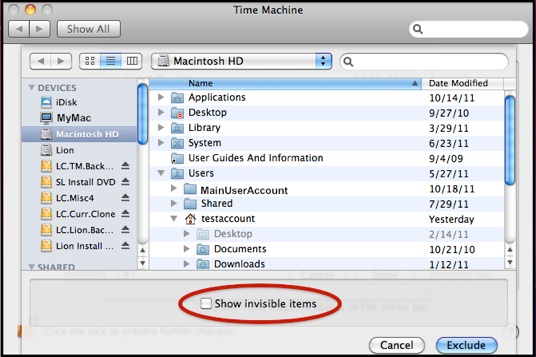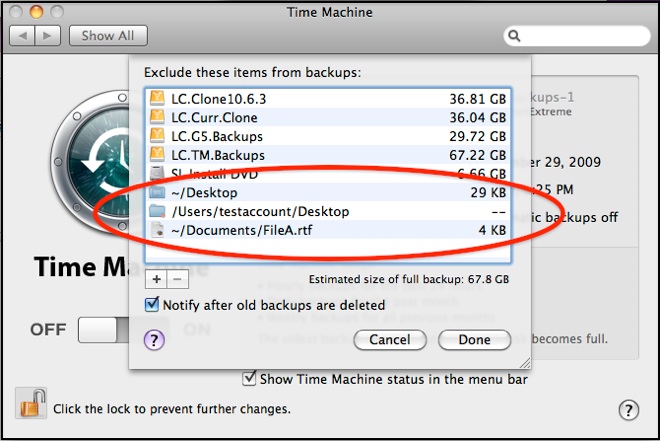Time Machine - Frequently Asked Questions
10. Can I exclude things from Time Machine backups?
Time Machine - Frequently Asked Questions
10. Can I exclude things from Time Machine backups?

If you can't find it, and its name starts with a dot (period), or it's in a top-level folder that doesn't appear when you click your internal HD in the sidebar, it's a hidden item. Click the Show invisible items box to make it show up.
Select it, click Exclude, then Done.
Note that if an item is already specifically excluded, it will be shown in gray, like the Desktop folder in the testaccount home folder in the sample. If a volume (drive or partition) is show in gray, it's either your Time Machine backup volume, or it's not formatted for a Mac and Time Machine can't back it up.
See question #11 for advice on what to exclude, and what not to exclude.
Note that if a user account is protected by the original File Vault (not File Vault 2 on Lion), you can select things inside that user’s home folder here, but those selections will be ignored: the entire encrypted home folder will be backed up when the user logs out. See question #25 for more on how original File Vault works with Time Machine.
If you exclude an external disk/partition, when you disconnect it, it will disappear from the exclusion list, but will reappear when you connect it again.
When you click the Done button to change exclusions, a new backup will be started automatically (in 120 seconds, or immediately when you quit System Preferences.
If a backup is already running, it will be cancelled and restarted.

Sure. Go to Time Machine's Preferences window and click Options.
Multiple Users:
If you want to exclude things from multiple user accounts on your Mac, it's usually best to log on to each account and exclude the desired items from that account.
When you view the exclusions, those in the home folder of the currently logged-on user will be shown with the ~ notation, such as ~/Desktop or ~/Documents/FileA.rtf. Those in a different user's home folder will be shown with their full "path:" /Users/<account>/Desktop if the logged-on user has read rights to it, but will not be shown at all if it doesn't.
In the sample, both users have excluded their Desktop folders, and the FileA.rtf in their Document folders. Notice the Desktop folder for the testaccount has a small red indicator in the icon, and no size shown, and that Documents/FileA.rtf for the testaccount is not shown. That's because the logged-on user can see testaccount's Desktop and Documents folders, but not the contents of them. Those are the default permissions; one user, even an Admin user, normally doesn't have access to another user's files.

If you choose Exclude All System Files, that excludes the System folder and all the standard Apple apps in your Applications folder. Your 3rd-party apps and Apple apps purchased separately, such as iLife and iWork, will not be excluded (ie, they will be backed-up). Click the question mark symbol for details.
There are serious downsides to these exclusions: for one, you cannot do a full system restore if you don't back up your system. See the pink box in question #11.

In the next panel, click the plus sign at the bottom.
Note that if you're backing-up to an external HD, your Time Machine volume is excluded by default, shown in gray, and you cannot remove it.
Any drives or partitions that aren't formatted for a Mac can't be backed-up, so are also shown in gray and can't be removed.
Also note that the options in the lower portion vary with the version of OSX you're on and whether you have a portable Mac.
